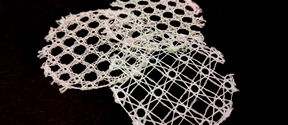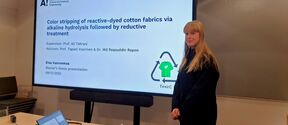International Design Business Management (IDBM) (external link)
The programme combines design and technology with global business development.
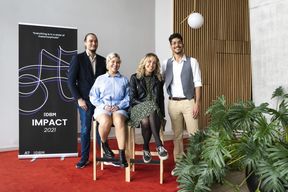
KONE and Aalto University have a long-standing teaching collaboration. A key component of this is study projects, in which student teams work to solve companies’ real-life challenges. An example of multidisciplinary collaboration is IDBM Master’s Programme (International Design Business Management), in which students complete seven-month projects with companies.
KONE’s projects foster future technologies and solutions for sustainable development and investigate the change factors for user and customer needs and for operating and market environments.
‘When 4–6 highly motivated students from different fields tackle together a complex real-life challenge provided by a partner company, it generates new thinking and innovative concepts. Design methods enable us to solve problems in a user-driven and comprehensive way,’ says IDBM Community Manager Apurva Ganoo from Aalto University.
Last year, in KONE’s Urban flow service robot ecosystem project, students set their sights 10–15 years ahead into the world of transport robots. ‘At the moment, the majority of goods-transporting robots are in industrial use. We decided to focus on robotics operating in large multipurpose buildings. We explored the related business models and opportunities, as well as KONE’s role in the market,’ explains Moona Haapala, an engineering student from Aalto University School of Science.
In collaboration between companies and students, both sides learn and grow. The students challenge the company to see things from an outside perspective and bring new thinking into the game.
‘At the core of our business are the solutions that add value to our existing and future customers. Design engages different stakeholder groups thus enabling us to discover phenomena and new business opportunities, in which different perspectives of sustainability meet – social, economic and environmental,’ explains KONE Strategic Foresight Manager Jaana Hyvärinen.
The robotics team carried out their work in close cooperation with KONE representatives and started by defining the core problem. ‘In the weekly Zoom meetings, students presented questions and ideas to which they then received perspectives from the business world,’ explains Ganoo, who was responsible for mentoring the student team.
The design process does not lock down on the initial, obvious options that arise which allows introducing new, even surprising opportunities and insights. ‘People from different backgrounds have different in-built habits for how to set about solving a problem. Our world expanded when we realised “hey, you have a good idea and I have a good idea – what if we combined them and got something completely new,”’ Haapala recalls.
The size of the global service robot industry currently stands at around 200 million euros, and is set to reach one billion euros within five years. The use of transport robots does not depend solely on technological development. Instead, changes are needed in areas such as the user-orientation of robot services and the equipment installed in smart buildings.
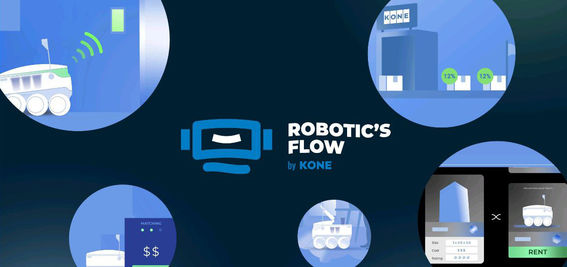
‘We developed the KONE robotics flow platform, which provides a secure and reliable marketplace for service robots. The platform brings together robot manufacturers, users, and other operators and makes smart building infrastructure available to them,’ explains Aalto University design student Rohan Sachdeva.
Jere Vuorenala, Project Manager in KONE Strategic Design team, who supervised the student team, is pleased with the results: ‘The team had a wide understanding of the business context and was able to respond to business challenges. The students’ background research and interviews brought valuable new insights on the topic. The results are practical and can also be applied in our other projects.’
Projects based on real-life challenges get enthusiastic feedback from students, as they bring a connection with the world of work and increase understanding of company activities and operating environments.
‘It was really valuable that the KONE representatives gave our team so much time and input. The study project is a big motivational boost for students because you get to put theory into practice and work for cool and interesting companies,’ Haapala says.
For companies, project work is also a great way to get to know the experts of the future. ‘Following the IDBM project, several students have come to us for summer internships or thesis work and through this ended up working for KONE. Many of our employees have completed the IDBM programme during their studies and now have the opportunity to participate in the project work as supervisors,’ Hyvärinen adds.
Internationality is an integral part of the collaboration. The student team itself is often international, which adds value to its work and results. Typically, during an IDBM project the teams travel abroad. At the overseas location, they carry out user research and customer interviews and may organise events such as workshops for local experts.
‘KONE’s projects have included field trips all over the world, even as far away as Asia and South America. In the work carried out on these trips, we are able to utilise the students’ international backgrounds and understanding of different cultures,’ Hyvärinen explains.
Last year, coronavirus prevented these trips from taking place. The robotics team students were not discouraged, however. They contacted several international companies and stakeholders and carried out focused interviews that formed a valuable part of the team’s extensive research report.
Project ends with a celebration in the Impact Gala, in which all the student teams present their work to each other and to their partner companies. ‘In the final performances, I am always impressed by how well young students pitch their ideas. The presentations are very professional, with every detail carefully thought through,’ Hyvärinen enthuses.
Text: Marjukka Puolakka

The programme combines design and technology with global business development.

In study projects, students solve real-life cases together with companies and other organisations.
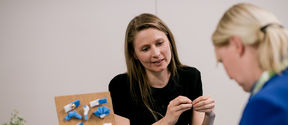
Research collaboration strengthens expertise and future business development. New product and service ideas are created in study projects. Our campus offers an inspiring operating and networking environment. At Aalto's recruitment events, companies meet the top talents of the future.

